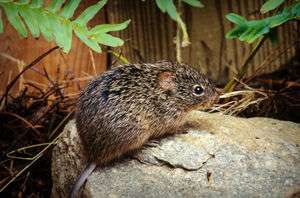Cotton rat
A cotton rat is any member of the rodent genus Sigmodon. Cotton rats have small ears and dark coats, and are found in North and South America. Members of this genus are distributed in the Southwestern USA, Mexico, Central America and South American countries of: Venezuela, Ecuador, Colombia, Peru, Brazil, Guyana and Suriname. Many of the species are found in Mexico.
| Cotton rats Temporal range: Early Pliocene - Recent | |
|---|---|
 | |
| Hispid cotton rat (Sigmodon hispidus) | |
| Scientific classification | |
| Kingdom: | Animalia |
| Phylum: | Chordata |
| Class: | Mammalia |
| Order: | Rodentia |
| Family: | Cricetidae |
| Subfamily: | Sigmodontinae |
| Tribe: | Sigmodontini Wagner, 1843 |
| Genus: | Sigmodon Say & Ord, 1825 |
| Species | |
|
Sigmodon alleni | |
They are primarily herbivores. The molars of cotton rats are S-shaped when viewed from above. The genus name literally means S-tooth.
Sigmodon hispidus was the first model organism to be used in polio research.
Classification
- Genus Sigmodon
- Subgenus Sigmodon
- Sigmodon hispidus species group
- Sigmodon alleni - Allen's cotton rat
- Sigmodon arizonae - Arizona cotton rat
- Sigmodon hirsutus - Southern cotton rat
- Sigmodon hispidus - Hispid cotton rat
- Sigmodon mascotensis - Jaliscan cotton rat
- Sigmodon ochrognathus - Yellow-nosed cotton rat
- Sigmodon planifrons - Miahuatlán cotton rat
- Sigmodon toltecus - Toltec cotton rat
- Sigmodon zanjonensis - montane cotton rat
- Sigmodon fulviventer species group
- Sigmodon fulviventer - tawny-bellied cotton rat
- Sigmodon inopinatus - unexpected cotton rat
- Sigmodon leucotis - white-eared cotton rat
- Sigmodon peruanus - Peruvian cotton rat
- Sigmodon hispidus species group
- Subgenus Sigmomys
- Sigmodon alstoni - Alston's cotton rat
- Subgenus Sigmodon
References
- Musser, G.G.; Carleton, M.D. (2005). "Superfamily Muroidea". In Wilson, D.E.; Reeder, D.M (eds.). Mammal Species of the World: A Taxonomic and Geographic Reference (3rd ed.). Johns Hopkins University Press. pp. 894–1531. ISBN 978-0-8018-8221-0. OCLC 62265494.